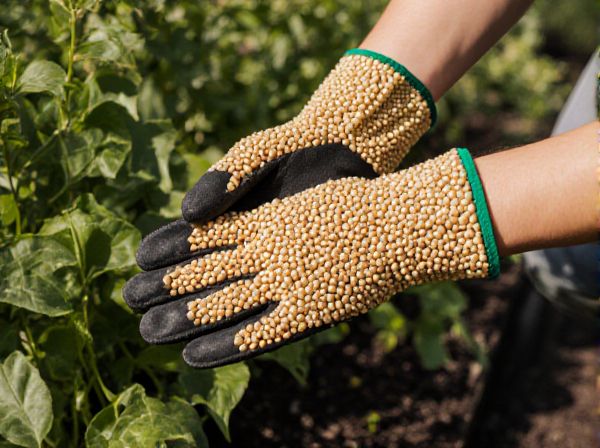
Pelletized vs Powdered Illustration
Pelletized fertilizer offers controlled nutrient release and reduces runoff compared to powdered fertilizer, which dissolves quickly and provides immediate nutrient availability. Pelletized forms are easier to handle and apply with less dust, improving safety and minimizing waste. Powdered fertilizers, however, allow for faster absorption by plants, making them ideal for rapid nutrient correction.
Table of Comparison
| Feature | Pelletized Fertilizer | Powdered Fertilizer |
|---|---|---|
| Form | Granulated, compact pellets | Fine, loose powder |
| Application | Easy spreading, less dust | Requires precise measuring, dustier |
| Storage | Longer shelf life, moisture resistant | Higher moisture absorption, shorter shelf life |
| Absorption Rate | Slower nutrient release, controlled feeding | Faster nutrient uptake, immediate effect |
| Handling | Less prone to spillage and mess | Messier, requires careful handling |
| Best Use | Large-scale agriculture, lawn care | Greenhouse, small gardens, and foliar feeding |
| Cost | Generally higher due to processing | Usually lower, more economical |
Introduction to Pelletized and Powdered Fertilizers
Pelletized fertilizers contain nutrients compacted into small, uniform granules that improve application accuracy and reduce dust, enhancing soil absorption and minimizing runoff. Powdered fertilizers offer rapid nutrient availability due to their fine particle size, making them ideal for quick nutrient uptake but can pose handling challenges like dust generation. Choosing between pelletized and powdered forms depends on application method, crop type, and environmental considerations to optimize fertilization efficiency.
Composition Differences: Pelletized vs. Powdered
Pelletized fertilizers consist of compacted granules that release nutrients gradually, allowing for controlled feeding and reduced runoff, while powdered fertilizers are finely ground particles that dissolve quickly, providing immediate nutrient availability. Pelletized forms often contain binders and fillers to maintain pellet shape, which can affect the nutrient concentration compared to the more concentrated powdered forms. The physical differences influence application methods and nutrient release rates, with pelletized fertilizers being preferred for long-term soil enrichment and powdered fertilizers suited for rapid nutrient correction.
Application Methods Compared
Pelletized fertilizers offer precise application through controlled-release granules that reduce nutrient runoff and enhance soil absorption efficiency, making them ideal for large-scale agricultural use and mechanized spreading. Powdered fertilizers dissolve quickly, allowing for rapid nutrient availability and ease of integration into irrigation systems such as fertigation, which benefits high-value crops requiring immediate nutrient uptake. Application method selection depends on crop type, soil conditions, and nutrient release timing, with pelletized forms suited for steady feeding and powdered forms preferred for fast, uniform distribution.
Nutrient Release Rates and Availability
Pelletized fertilizers provide a slower, more controlled nutrient release beneficial for long-term crop feeding, while powdered fertilizers offer rapid nutrient availability suited for immediate plant uptake. The granulated form of pelletized fertilizer reduces nutrient leaching and improves efficiency by releasing nutrients steadily over time. In contrast, powdered fertilizers dissolve quickly in soil moisture, delivering nutrients instantly but with a higher risk of runoff and leaching losses.
Ease of Handling and Storage
Pelletized fertilizer offers superior ease of handling and storage due to its compact, uniform shape that reduces dust and spillage, facilitating cleaner transportation and application. Powdered fertilizer, while potentially providing faster nutrient release, is more prone to caking and dispersal during handling, requiring airtight containers and careful storage conditions to maintain quality. Choosing pelletized forms minimizes labor and equipment wear, optimizing operational efficiency in agricultural practices.
Suitability for Different Garden Types
Pelletized fertilizer offers slow-release nutrients ideal for large lawns and ornamental gardens where uniform feeding is essential, reducing the risk of over-fertilization. Powdered fertilizer dissolves quickly, making it suitable for vegetable gardens and small container plants that require immediate nutrient availability and precise application. Both types cater to different garden needs, with pelletized fertilizers favoring long-term feeding in spacious areas and powdered forms supporting fast nutrient uptake in confined or sensitive spaces.
Environmental Impact and Runoff Concerns
Pelletized fertilizer reduces the risk of nutrient runoff by offering controlled release properties, minimizing excess nutrient leaching into waterways. Powdered fertilizer, with its finer particles, tends to dissolve quickly but increases the potential for runoff during heavy rain, posing a greater threat to aquatic ecosystems. Choosing pelletized formulations can enhance nutrient retention in soil, supporting sustainable agricultural practices and reducing environmental pollution.
Cost Comparison and Value
Pelletized fertilizers generally have a higher upfront cost compared to powdered fertilizers due to their processing and manufacturing requirements. Despite the greater initial expense, pelletized fertilizers offer better nutrient retention, reduced application waste, and ease of handling, which can lead to improved long-term value and efficient crop yield. Powdered fertilizers, while cheaper initially, may require more frequent application and careful management to avoid nutrient loss, potentially increasing overall costs over time.
User Recommendations and Best Practices
Pelletized fertilizers offer controlled nutrient release, making them ideal for long-term crops and reducing leaching risk, while powdered fertilizers provide immediate nutrient availability suited for fast-growing plants or greenhouse settings. Users should apply pelletized forms according to soil moisture and temperature conditions to optimize nutrient uptake and minimize waste. For powdered fertilizers, precise dosage and uniform distribution are crucial to avoid nutrient burn and ensure effective absorption by plant roots.
Conclusion: Choosing the Right Fertilizer Form
Pelletized fertilizers offer controlled nutrient release and ease of application, making them ideal for large-scale farming and slow nutrient supply. Powdered fertilizers provide rapid nutrient availability and are suitable for quick soil amendment or foliar feeding but require careful handling to avoid dust and uneven distribution. Selecting the right fertilizer form depends on specific crop needs, soil conditions, and application methods to maximize nutrient efficiency and crop yield.
Pelletized vs Powdered Infographic

 gardendif.com
gardendif.com